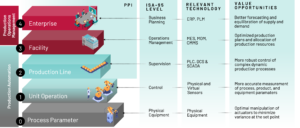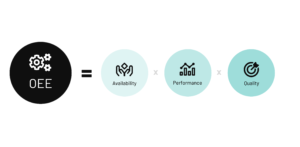Improving Production Performance
Through Better Management and Use of Data
In today's digital manufacturing landscape, harnessing factory data effectively and efficiently is a foundational capability needed for transformative change. Rockwell Automation’s recently published 9th Annual State of Smart Manufacturing report revealed that large manufacturers only utilize 51% of their data effectively. Maximizing the value of production and enterprise data to drive actionable insights across the value chain can generate significant increases in revenue and improvements in profitability. Industrial Data Management (IDM), Rockwell Automation’s Service Line for these data–process–technology solution sets, helps you monetize the value of your data and the investments you make in acquiring and analyzing it.
Industrial Data Management
Industrial Data Management involves harnessing data from intelligent industrial automation systems to gain deeper insights into factory operations. Gone are the days of manual data collection and disjointed analyses. With data management, factory assets communicate their statuses, operating and other data to enable real-time monitoring and proactive decision-making in production operations. For asset performance and reliability, these diffuse data are converted into information, allowing factory operators to advance rapidly from today’s still-prevalent "run-to-failure" approach to proactive and predictive performance models. This establishes a factory-wide Industrial Data Fabric that enables the integration of advanced capabilities like machine learning and artificial intelligence into many aspects of production and supply chain operations.
An Industrial Data Fabric is an architecture that uses intelligent and automated systems to integrate various data pipelines across on-premise and cloud environments within industrial settings. The result is contextualized and governed data that can be managed to break down data silos and decision-making bottlenecks to drive enterprise visibility and collaboration.
Industrial data management spans the IT/OT technology “stack” of plant operations. It delves deeper by leveraging the structured framework of the ISA-95 hierarchy shown in the diagram below. This framework fosters a comprehensive understanding of the criticality of operational efficiency across all areas of the plant.

Revealing, Quantifying and Resolving Production Inefficiencies and Challenges
The production inefficiencies most often resolved through data management solutions include unplanned downtime, speed loss, changeover inefficiencies, micro-stoppages and supply chain-driven losses. Acknowledgement, focused analysis and mitigation of these challenges can greatly improve production efficiency and resilience.
Unplanned Downtime
Unplanned downtime continues to be a primary concern for factory operators. The inability to swiftly diagnose and address the root causes of downtime can translate to significant losses in productivity and revenue. Industrial Data Management offers a solution by enabling granular monitoring of production processes, identifying even minor stoppages, and optimizing Overall Equipment Effectiveness (OEE).
Speed Loss and Time Inefficiencies
Industrial Data Management also proves particularly adept at addressing speed loss and time inefficiencies that result in production setbacks, a common worry for factory operators.
Consider a scenario where the target is to produce 10 widgets per minute, yet only 9 are manufactured. Leveraging data analysis capabilities, PPI can pinpoint the specific areas where productivity is lagging, providing valuable insights into the root causes of the production shortfall.
Supply Chain Issues
Supply chain issues often ripple through factory operations, affecting material availability, changeover times, and finished goods inventory levels. Industrial data management addresses these challenges by supporting production schedule optimization, minimizing changeover times, and aligning manufacturing processes with demand fluctuations.
Industrial Data Management Enhances Resiliency, Agility and Flexibility
Resiliency is measured by the time taken to restore productivity after disruptions. Whether it’s recovering from unplanned downtime or external events impacting production, swift restoration is crucial.
The ability to forecast and mitigate potential disruptions enhances a factory’s resilience, ensuring minimal disruptions to operations.
Agility is characterized by the ability to change rapidly from one product to another, while flexibility enables customization or configuration to meet diverse customer demands and complements resiliency in ensuring optimized production processes.
Industrial Data Management focuses on bringing visibility and actionable insights to performance and improvement opportunities to increase resiliency, agility and flexibility in operations.
Foundational Industrial Data Management Principles in the Digital Factory
At its core, industrial data management revolves around the integration of technology and processes with well-established manufacturing principles.
Rather than introducing new techniques, PPI focuses on leveraging data effectively to enhance continuous improvement (CI) processes.
By harnessing principles such as waste reduction and lean principles Kaizen and Gemba, in conjunction with digital capabilities, IDM empowers factories to drive exponential impact on operational efficiency. Furthermore, the ISA-95 stack (and related frameworks) promote hierarchical organization and seamless data exchange, respectively, highlighting the fusion of digital capabilities and Lean principles in enabling proactive and adaptable production optimization.
Overall Equipment Effectiveness Revisited
Although it's not the sole indicator of performance, OEE is a primary metric driving continuous improvement in manufacturing. It serves as a powerful tool in assessing the efficiency and productivity of manufacturing equipment and operations.

OEE considers three key factors:
- Availability: The percentage of time the equipment is available for production
- Performance: The rate at which the equipment operates compared to its maximum potential speed
- Quality: The ratio of good-quality output to total output
By analyzing the details of each of these components, OEE provides insights into equipment performance and helps identify areas for improvement in manufacturing processes.
By avoiding unplanned downtime and delving into root causes with PPI, factories can enhance availability, where even minor improvements in performance or quality can yield significant financial gains. Most manufacturers operate at 60% OEE, while world class manufacturers operate at 85% OEE or higher. OEE's holistic evaluation of equipment performance enables factories to pinpoint areas for enhancement, ultimately fostering greater efficiency and effectiveness in manufacturing processes. Imagine the financial and intangible benefits that can be realized with a 25-basis point improvement in OEE, including increased production and revenue, reduced scrap, and more predictable operations. With the development of an Industrial Data Fabric containing contextualized production and financial data, it’s possible to use PPI to equate the financial impact of even step changes in availability, performance and quality to guide the focus and prioritization of improvement efforts.
Conclusion
As factories embrace the principles of PPI, they position themselves for greater resilience and competitiveness in an ever-evolving market landscape. By leveraging data, advanced analytics and Lean methodologies, manufacturers can unlock new levels of efficiency, drive continuous improvement across their operations, and contribute rich, contextualized data to an Industrial Data Fabric that can provide significant value in areas beyond the capabilities of traditional OEE. Watch for future articles that expand on the Industrial Data Fabric and other use cases that leverage PPI.
Interested in learning more?
Check out the latest webinar with our authors.


